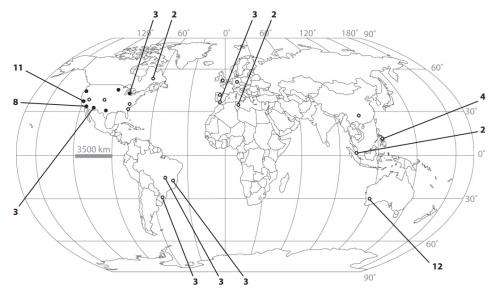Paleoclimate, proxies, paleosols, and precipitation

Precipitation reconstructions are essential for predicting impacts of future climate change and preparing for potential changes in terrestrial environmental conditions, such as shifting amounts of regional rainfall, which in turn impact water resource availability and crop growth patterns. Reliable proxy records of paleoprecipitation, especially from past warm periods, are a valuable tool for assessing and modeling future soil and plant moisture and local water availability. However, current terrestrial proxies are limited in their applications, and as a result, a wide range of paleoenvironments are underrepresented in the geologic record.
In their GSA Bulletin study, published online ahead of print on 3 Feb. 2015, Ethan G. Hyland and colleagues present a new relationship between the magnetic properties of soils and precipitation, and use this new proxy to describe changes in paleoprecipitation during past periods of major climate change. This work doubles the potential range of terrestrial paleoclimate applications, and has great potential for robustly describing hydrologic conditions in the deep past. Improvements in our understanding of these conditions can lead to more accurate predictions of water availability and ecosystem stability in a warmer world.
Because soil formation occurs in most terrestrial ecosystems and is controlled strongly by climatic factors, paleosol-based proxies provide an important archive of terrestrial climate. These records are ideal because they are applicable to significantly longer time scales than records from ice cores, and they give greater spatial fidelity and temporal coverage than records from sources such as lake cores or botanical (pollen) records.
Understanding precipitation in the present and during past episodes of climate change is important for determining and preparing for impacts of changes in the hydrological cycle on global environmental systems in the future. Soil magnetic properties, specifically the ratio of pedogenic goethite to hematite in modern soils, can be related quantitatively to modern precipitation regimes worldwide via a robust linear regression model. This newly derived relationship serves as a precipitation proxy that is applicable to a wide range of soil types and climatic regimes worldwide, and the resulting climo-function has been successfully applied to paleosols in order to estimate paleoprecipitation during the early Eocene climatic optimum, an interval of rapid global climate change.
More information: "A new paleoprecipitation proxy based on soil magnetic properties: Implications for expanding paleoclimate reconstructions." G. Hyland et al., University of Washington, Seattle, Washington, USA. Published online ahead of print on 3 Feb. 2015; dx.doi.org/10.1130/B31207.1.
Provided by Geological Society of America


















